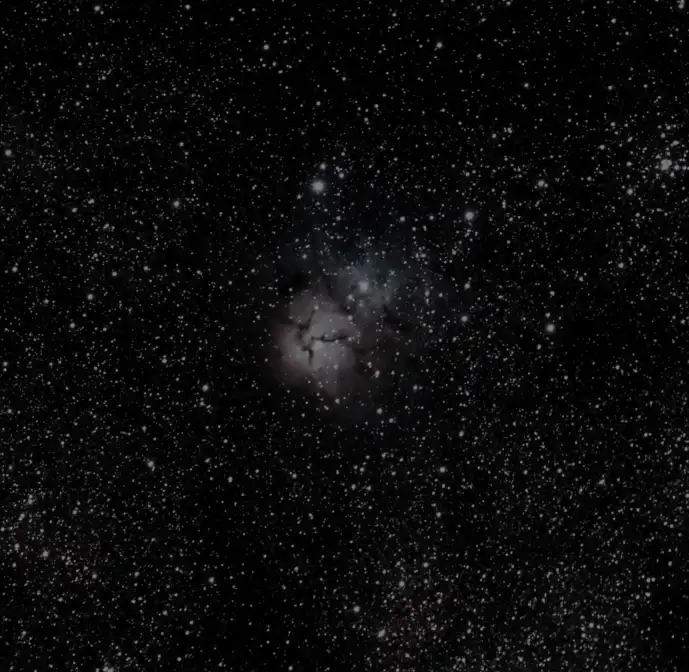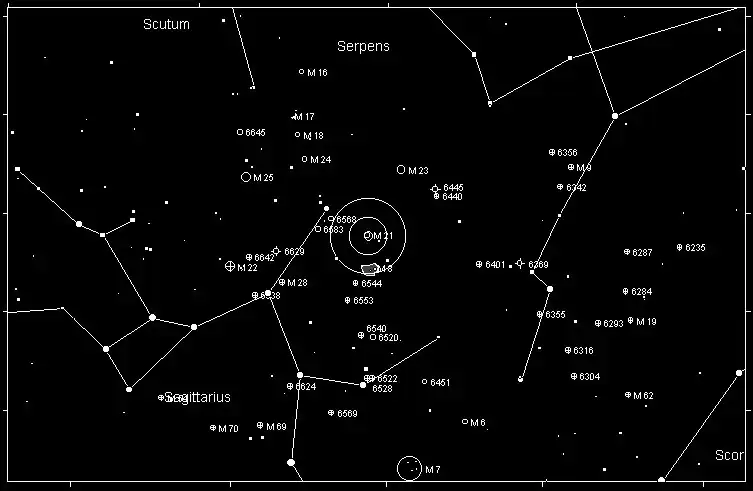Messier 20, also known as the Trifid Nebula, is a fascinating celestial object that combines several types of nebulae into one region of space. Located in the constellation Sagittarius, the Trifid Nebula gets its name from its distinctive three-lobed appearance, where dark dust lanes divide the nebula into three bright sections. This object is a combination of an emission nebula, a reflection nebula, and a dark nebula, making it a dynamic and colorful region of space. The emission nebula glows red due to ionized hydrogen, the reflection nebula appears blue as it reflects starlight, and the dark nebula is seen as the lanes that split the bright sections.
Magnitude
The Trifid Nebula has an apparent magnitude of +6.3, making it visible to the naked eye under very dark skies but much easier to observe through binoculars or a telescope. Although it is not one of the brightest objects in the sky, its complexity and beauty make it a popular target for amateur astronomers and astrophotographers alike.

Prominent Season
Messier 20 is best viewed during the summer months, especially in July and August when Sagittarius is high in the southern sky for observers in the Northern Hemisphere. This is the prime time to explore the rich region of the Milky Way around the Galactic Center, where the Trifid Nebula is located.
Constellation
The Trifid Nebula resides in the constellation Sagittarius, which is famous for containing the asterism known as the "Teapot." Sagittarius is one of the constellations that lies along the plane of the Milky Way, making it rich in nebulae, star clusters, and other deep-sky objects. Messier 20 is located near another well-known nebula, Messier 8, also known as the Lagoon Nebula.
How to Find Messier 20
Finding the Trifid Nebula is a rewarding experience, especially if you're exploring the dense star fields of the Sagittarius constellation. To locate M20:
- Locate Sagittarius: Find the "Teapot" asterism in Sagittarius, which is easily identifiable by its distinct shape. The "spout" of the teapot points toward the Galactic Center, a region packed with interesting objects.
- Find Messier 8 (Lagoon Nebula): The Lagoon Nebula (M8) is a bright, easily visible nebula located near the "spout" of the Teapot. It's a useful reference point for locating M20.
- Look Slightly North: From Messier 8, move your telescope slightly northward to locate the Trifid Nebula. It appears close to M8, and both nebulae can often be seen within the same field of view with low magnification.
- Use Low Power First: Start with a low-power eyepiece to get a wider field of view, which will make it easier to locate M20 in the dense star field. Once you have it in view, you can switch to higher magnification to resolve the details of the nebula.

History
The Trifid Nebula was discovered by the French astronomer Charles Messier in June 1764. Messier, known for cataloging nebulous objects that could be mistaken for comets, included the Trifid Nebula as number 20 in his famous catalog. While Messier described it as a small cluster of stars enveloped in nebulosity, it wasn’t until later that the true nature of the Trifid was revealed.
William Herschel, a British astronomer, observed M20 more carefully and noted the nebula’s dark lanes, which give it its trifid (three-part) appearance. However, the structure and complexity of the nebula were more fully appreciated with advancements in photography and modern telescopes.
In more recent years, the Hubble Space Telescope has captured stunning images of the Trifid Nebula, revealing intricate details of star formation within the nebula’s clouds. The dark lanes are now known to be regions of cold gas and dust, blocking the light from the background nebula. Within the Trifid, young stars are being born in energetic bursts of stellar wind and radiation, shaping the surrounding gas and dust into beautiful and complex patterns.
Conclusion
Messier 20 is one of the most visually striking objects in the summer sky, offering a blend of emission, reflection, and dark nebulae. As part of the rich Sagittarius constellation, it is a must-see target for amateur astronomers. Whether viewed through a telescope or captured in photographs, the Trifid Nebula continues to captivate stargazers with its beauty and the dynamic processes occurring within.
